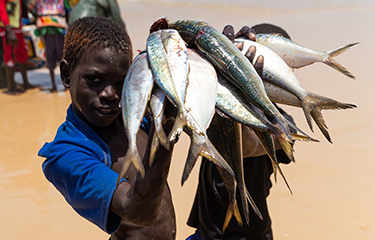The expansion and improvement of the fishmeal and fish oil industry in West Africa has triggered huge appetite for the flat sardinella (Sardinella aurita and S. maderensis) and bonga (Ethmalosa fimbriata) – fish species that are considered critical in meeting the region’s food demands, but are also overexploited to the point of near-depletion.
“The current situation is one of over-exploited and depleted fish stocks and a rapidly increasing shift of catches from human consumption to the production of fishmeal and fish oil for export,” according to a new report from non-governmental environmental organization Greenpeace.
“We’re losing hundreds of thousands of [metric tons] of edible fish to fishmeal and fish oil (FMFO) exports, potentially impacting 40 million African consumers,” Greenpeace Africa Oceans Campaign Manager Ibrahima Cisse said in the new report.
Greenpeace has expressed concern at the failure of West African governments to prevent the degradation of regional fish stocks, as well as the increasing fishmeal practice of “taking fish from people’s plates to feed fish farms, pigs, or poultry in faraway markets.”
“Catches that could be made by artisanal fishermen and the women who process them - which could feed low income families - is exported to be used as animal feed. It makes no sense,” Cisse said.
An estimated 50 FMFO factories have been developed in the region, mostly in Mauritania, Senegal, and Gambia. Greenpeace’s survey confirmed that 40 of the processing plants remain active in 2019. The FMFO factories export primarily to the European Union, China, and some of the African countries.
“Exports of FMFO from Mauritania have doubled between 2014 and 2018, making this country now the largest exporter of fishmeal and fish oil in the region,” the Greenpeace report said.
An estimated 550,000 metric tons of pelagic fish were harvested to supply the FMFO processing plants in Mauritania in 2017.
“Greenpeace Africa calls on West African governments and companies to face their responsibilities in the much-needed protection of regional fish stocks, as well as prioritise basic human rights: food security and the livelihoods of artisanal fishermen and women processors,” the report added.
The World Bank has estimated sub-Saharan Africa’s fishmeal production to be 170,000 tons in 2010, volumes that are set to increase to 192,000 tons and 203,000 tons by 2020 and 2030, respectively.
However, in what appears to be a reduction in local use and an increase in exports of the fishmeal production, the World Bank predicted utilization of the product to reach 105,000 metric tons (MT) in 2020, down from 208,000 MT in 2010, with a further slide to 67,000 MT in 2030.
Although the use of processing fish waste could reduce pressure on capture fisheries for the making of fishmeal and fish oil, the World Bank warned that “expanded processing capacity and markets could also result in greater reduction in demand for fish including those that otherwise would be used for direct human consumption and potentially encouraging harvest of all kinds of fish, including some protected and endangered species.”
At least 20 percent of fish produced is currently utilized for FMFO, and the situation is likely to remain constant until 2030, according to the World Bank.
The global fishmeal production would rise to 7.6 million tons by 2030, with sub-Saharan Africa’s share expected to rise 2.7 percent, the bank added.
Image courtesy of Elodie Martial/Greenpeace







